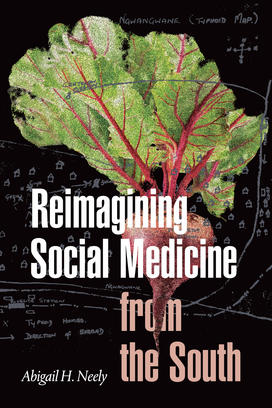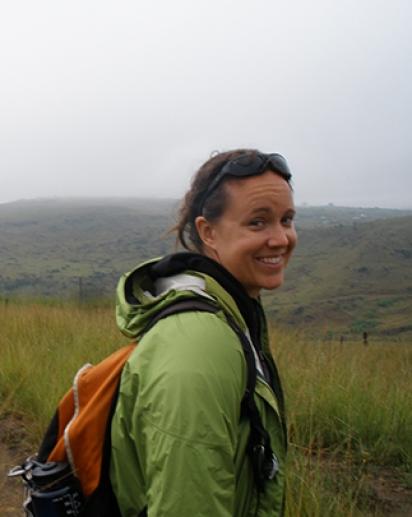Abigail H. Neely ’01 Explores Social Medicine in South Africa

The author: Abigail H. Neely ’01 is an assistant professor of geography at Dartmouth College. As a political ecologist trained in geography’s nature-society tradition, she studies relationships between the material world and the way people understand that world, as mitigated through institutions, culture, and experience. Neely previously served as an assistant professor at the University of Minnesota. She has an A.B. in history from Princeton, an M.Sc. in society and environmental policy from the University of Oxford, and a Ph.D. in geography from the University of Wisconsin-Madison.
Opening lines:
One hot April afternoon in 2009, I sat with a remarkably healthy older Zulu-speaking woman in her garden in Pholela, South Africa. We were discussing common health concerns among her generation. Gogo (Grandma) Ngcobo had an impressive garden. In addition to maize, millet, and sorghum, she grew vegetables like spinach, green peppers, beetroot, and carrots. Organized in separate beds and planted in rows, Gogo Ngcobo’s garden could have served as an advertisement for scientific management.
As we sat under a shady tree, she told me that the loss of “traditional” foods had led to hypertension and type 2 diabetes. In particular, she blamed the “new” store-bought maize meal people consumed in large quantities, claiming it was not as healthy as the maize meal made by people from their own corn. When maize meal is processed, she explained, “this little thing in the middle of the maize kernel is taken out,” and the maize is ground without it. This little piece was important, Gogo told me, because it was the “healthy part.”
As conversations about health in 2009 were wont to do, Gogo’s became a lament about the poor health of the “youth” (people between the ages of fifteen and thirty-five). While she acknowledged that the youth were suffering (and dying) from “these diseases” (often understood as a gloss for HIV/AIDS), she claimed that bad food was the reason the youth were so sick in the first place. According to Gogo, young people in Pholela were getting sick because they had “weak blood.” She blamed this weak blood on the consumption of “bad food” like commercial maize meal and cooking oil. Cooking oil, she explained, goes to the knees and makes them sore; even the smell makes her stomach “sad.” She went on to say that undercooking and boiling (as opposed to frying) food from the garden is the healthiest option. This cooking method is important for preserving the food’s “nutrients.” “Nutrients are important because they help the blood to function well.” And well-functioning blood is key for good health.
As I sat in the shade chatting with Gogo, I remembered one of my first visits to her garden. I had asked her to give me a tour. We ambled around and she showed me the grains and vegetables that she would later reap and eat and pointed with pride to the ornamental plants and trees she had received from her children working in distant cities. As we got to the middle of the garden, I pointed to a small, unfamiliar plant with long leaves and asked Gogo what it was called and what it was for. She looked at me and smiled, slightly embarrassed, “Oh that? It’s nothing. It’s just intelezi.” Intelezi is the plant used to make the umuthi (medicine or potion) for annual protection rituals, which protect people, animals, and crops and the spaces they inhabit from witchcraft. Gogo was growing intelezi so that she could protect her home, her garden, and her family. While Gogo Ngcobo had a sophisticated understanding of nutrition and its importance for health, she also understood that she needed to protect herself and her family from witchcraft.
Gogo Ngcobo grew up in the catchment of a major social medicine program. In 1940, in a rare moment of concern for the health and welfare of all South Africans, the government sent a young, untested team to a remote, mountainous area in an African Reserve in what was then the province of Natal to set up the Pholela Community Health Centre (PCHC). Together, they developed an experiment in social medicine that became known as community-oriented primary care (COPC). This new brand of social medicine stressed the social as well as the biological causes of illness, blending clinical care at the health center with health education and extension work in the homes of area residents. This multi-sited approach required the efforts of doctors, nurses, health educators, and Pholela’s residents, as the health center sought to improve health and lives collaboratively. And it did. Infant and crude mortality plummeted, gross malnutrition all but disappeared, and new cases of illnesses like syphilis decreased markedly. Just a decade after its inception, and by many measures, the PCHC was a rousing success. It was so effective, in fact, that it has been referred to as “a model for the world,” and some call it one of the most successful social medicine interventions in history.
As the conversations I had with Gogo Ngcobo in her garden reveal, the work of the PCHC shaped the ways in which residents understand their health and the homesteads they reside in. Gogo Ngcobo’s comprehension of the role of food in health, her eating habits, her own good health, and the scientific form of her garden reveal the long-lasting impacts of the social medicine developed in Pholela. In many senses, Gogo Ngcobo and her garden offer a picture of the success of the health center’s work in transforming homesteads and improving health. But Gogo’s garden shows something else too. It shows that she continued to be concerned about illnesses the health center could not see or treat. The intelezi in the garden reveals that the health center’s approach to healing was not monolithic. Gogo Ngcobo and her homestead inhabited two different, if interconnected, worlds of health and healing.
This book offers a story of social medicine, written from an out-of-the way place in sub-Saharan Africa that happens to be one of its most important origin sites. It tells a story of social medicine’s possibilities and limitations through the lives, homesteads, and health of the people who were the subjects of the Pholela Community Health Center’s experiment. As such, it offers an alternative to more common accounts, which tend to feature laudatory narratives of white, male doctors who practice medicine to fight for social justice. While doctors are an important part of this story, they are not at its center; Pholela’s residents are. In this place, people lived in and made different worlds as they got sick and became well. These worlds were populated by people, things, and harder-to-categorize beings like ancestors. From the PCHC’s perspective, there was one health reality on top of which different sets of “beliefs” accumulated. The way to understand and intervene in health outcomes was through scientific study, not through consultation with ancestors. Gogo Ngcobo’s garden challenges this singularity. The worlds that residents and their gardens occupy shaped health outcomes in ways social medicine could not always understand and treat. For all of its many successes, the PCHC was limited by its own faith in science, both biomedical and social, as well as by broader political-economic forces at work in South Africa.
In the story I tell here, the successes and failures of social medicine resulted from the relationships among humans, nonhumans, and harder-to-categorize beings. Some of these relationships, like those between livelihoods and health, the PCHC recognized and actively worked to shift, drawing on the best social science of the time. But it did not and could not see all of the relationships. For example, the PCHC failed to take account of Pholela’s residents’ roles in the development of its practice, and it never recognized the sociality of the nonhuman things (nutrients, protected water sources) that were integral to its program. Moreover, the PCHC did not understand how important Pholela-specific social relationships, including those with ancestors, were to health and healing. Paying attention to social medicine in Pholela reveals that unexpected and entangled more-than-human relationships are the basis of social life and health and healing. By starting with relationships, this book offers a vision of social life in which individual actors disappear and health and illness emerge as the product of entanglements.
To make this relational approach to health and healing clearer, I return to Gogo Ngcobo’s garden. In some senses, the form of the garden, its diversity, and her ongoing good health could be attributed to the lessons she learned as a girl and the influence of the PCHC’s health educators. It was also testament to the relationships she and her family developed with the PCHC and with the things of health center work, like seeds and nutrients. The limitations of COPC remained visible in the garden and in our conversations too. The garden was small; its contents could last only a couple of weeks after the last harvest. As a result, Gogo Ngcobo and her family bought most of the food they ate. Gogo’s concern over processed maize meal reveals an anxiety about the ways in which racial capitalism curtailed the nutritional and health-related possibilities she and her family had access to by restricting land and wages for Africans. (Racial capitalism refers to the idea that capitalism has always been co-constituted with racism.) Gogo’s understanding of her limited food was evidence of the work of the PCHC and its health education efforts. While the health center could help residents modify homesteads and offer clinical care, it could not change the broad structures of racial capitalism that shaped livelihoods and health. This was not its only limit; the intelezi Gogo grew in her garden and her slight embarrassment at being asked about it (in the larger context of a conversation about agriculture and nutrition) reveal a second limit. This plant, the illness it was to prevent, and the world of health and healing it came from pose a challenge to an understanding of social life circumscribed by the social sciences. In Gogo Ngcobo’s good health and her knowledge, and in her garden’s contents and form, the relationships that set the stage for both the possibilities and the limitations of the PCHC’s social medicine remain visible to this day.
(Copyright © 2021 by Abigail H. Neely. Published by Duke University Press.)
Review:
“Compelling and original, Reimagining Social Medicine from the South rethinks core concepts in historical and anthropological discussions of health and healing in Africa through the lenses of political ecology and relational ontologies. Drawing on rich ethnographic and archival examples, Abigail H. Neely illuminates how robust conceptions of the ‘social’ at the heart of a pioneering social medicine project in rural South Africa nonetheless struggled to incorporate more-than-human understandings of life and well-being. The book's insistence that health and illness are entanglements that exceed the confines of the individual body and academic renderings of the ‘social’ alike is a call for place-based models for improving health that challenge global health's narrow frames of measurability and efficacy.” — Cal Biruk, author of Cooking Data: Culture and Politics in an African Research World












No responses yet